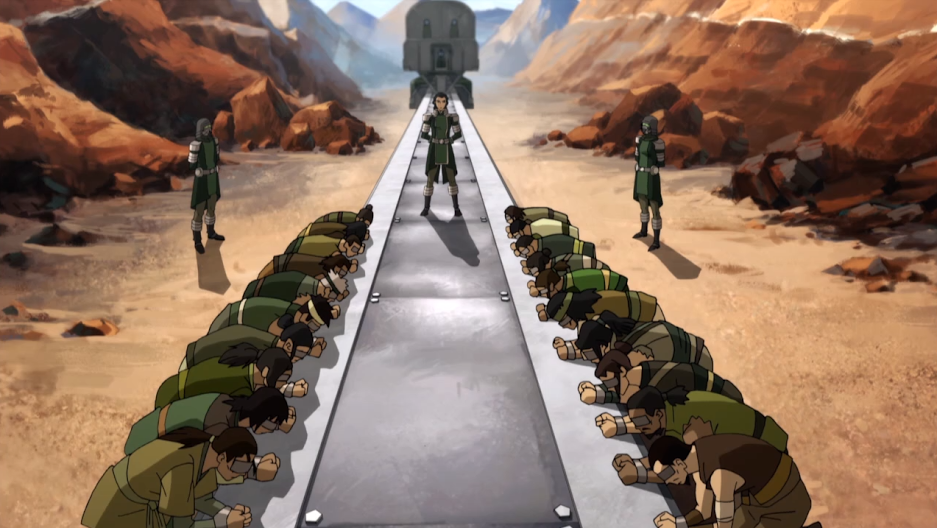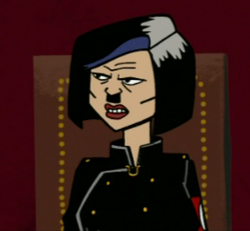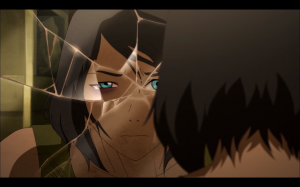Avatar: The Legend of Korra, Season 4: The rise of Girl Hitler

Season four of The Legend of Korra is starting off with plenty to talk about, both in terms of narrative content and how it’s being handled by Nickelodeon. Most notably, the network has decided to forego Korra’s cable TV presence altogether, and will instead be screening the entire season online at nick.com every Friday for the next several weeks. This move follows a string of questionable decision-making regarding Nick’s handling of Korra and the entire Avatar franchise, beginning with some indecision over the show’s second season timeslot in 2013, and coming to a head with the leaking of several Season 3 episodes earlier this year by the channel’s Latin American division.
The Legend of Korra on nick.com
This leak, it appears, was the precipitating event that lead both to Season 3’s rushed exhibition, and this season’s seemingly early release, premiering as it has less than two months since last season’s finale. This is unusual, at least for this franchise. After all, while it is fairly common for animated shows in the US to more or less seamlessly transition from season to season, this has not been the case until now for either Korra or it’s predecessor, Avatar: The Last Airbender (2005-8), both of which have been handled much more along the lines of prestige TV programming (or indeed, anime) than typical US kid’s animation. When taking into account budgets, production values, franchise history, cultural impact, and narrative complexity, one would expect Korra to be treated much more like a flagship series than it has been by Nickelodeon as of late. This move to an exclusively online distribution model for the show as such speaks not only to questionable management decisions on Nick’s part, but is also indicative more widely of the rocky process of transition to, and integration of, online distribution models by established TV networks. After all, Nick’s own online exhibition platform was the very source of the leaks that have now obliged Korra to reside solely online.
Though the decision to enact this transition was made well after this season was produced, it is entirely fitting with The Legend of Korra’s increasing departure from the profile Nickelodeon seems to want to build, with the show’s progressively conspicuous forays into interpersonal and sociopolitical depth and complexity. This is not to say the Avatar franchise hadn’t already set the groundwork for such development. The Last Airbender centered its own narrative within a hundred-year war of imperialist colonisation and genocide, and the first season of Korra itself featured (and actually engaged with) allegories of ethnic scapegoating and class struggle, as well as concluding with both a murder-suicide of its antagonists and contemplations of suicide by its main character—the titular Avatar, Korra. As the show has progressed, its narrative has moved decidedly away from The Last Airbender’s own brand of medieval Asian high fantasy towards a world that is starting to look much more like our own, albeit with elemental superpowers and an Asian inflection to Fordism and the Jazz Age.
Chapter One: After All these Years
With the premiere of Season 4 (Book 4: Balance), it seems as if the Avatar world shares another similarity with this time period, signaling as it does the rise of fascism, and the conditions that give rise to it. Where season 3 concluded with the Avatar’s defeat of the Red Lotus, a group of monomaniacal—though very well fleshed out and motivated—anarchist revolutionaries, the damage done by their assassination of the Earth Kingdom’s admittedly despotic queen has seemingly plunged the vast and diverse Earth Kingdom into disarray. Season 4 picks up thee years later, and quickly updates us on the whereabouts of all of Team Avatar except Korra herself, who only shows up in the last two minutes. Given the little we get to see of her in this first episode, she looks to be caught in a Deerhunter (or X-Men’s Wolverine)–style dynamic of post-traumatic self-destructive disassociation, fighting in low-rent earthbending cage matches and subtracting herself from her inherited and taxing role as this world’s spiritual (and political) mediator. Subsequent episodes will be dealing more closely with her.
In contrast, all our other protagonists have since entered into pivotal positions in the current political order as captains of industry (Asami), right-hands of monarchy (Mako), members of UN peacekeeper-style forces (The airbenders), and soldiers directly serving military elites in charge of national re-consolidation (Bolin).
Most notably, the female Earth Kindgom soldier Kuvira—a peripheral character  introduced very late into last season—has now ascended to become the figure seemingly in sole charge of this re-consolidation, traveling the countryside by rail and incorporating territories —and gangs of bandits— to her cause through intimidation, resource extortion, and, it seems, a strong cult of personality. It is here that we appear to have this season’s primary antagonist (if you may forgive this review’s titular reference to another contemporary and complex animated show, the Venture Brothers). Kuvira’s ascendance from soldier to nationalistic despot may perhaps be more akin to the rise of Mussolini or Franco than Hitler, but it is clear that, given the shades of class, ethnic scapegoating and political sedition that have gone on up until now, the Avatar world is seeing its own brand of fascism in the wake of its portrait of the inter-war period.
introduced very late into last season—has now ascended to become the figure seemingly in sole charge of this re-consolidation, traveling the countryside by rail and incorporating territories —and gangs of bandits— to her cause through intimidation, resource extortion, and, it seems, a strong cult of personality. It is here that we appear to have this season’s primary antagonist (if you may forgive this review’s titular reference to another contemporary and complex animated show, the Venture Brothers). Kuvira’s ascendance from soldier to nationalistic despot may perhaps be more akin to the rise of Mussolini or Franco than Hitler, but it is clear that, given the shades of class, ethnic scapegoating and political sedition that have gone on up until now, the Avatar world is seeing its own brand of fascism in the wake of its portrait of the inter-war period.
If this is the case, this will mark the first instance of a primary female antagonist in the franchise —something that runs par for the course in the show’s already strong and increasing integration of complex female representation. This presence was already present and notable in The Last Airbender, but has entered much more into the fore in Korra, from the positioning of women in active protagonistic roles, to their quotidian inclusion as political leaders, business executives, soldiers, civil servants, revolutionaries, and even low-level thugs. Indeed, if anything, the normalcy with which this productive presence is treated within this show’s diegesis is one of the series’ strongest indicators that this version of the 20s and 30s is truly not our own. This factor (along with both this show’s other agonistic narrative complexities and its position as a hybrid of Asian and Western models of animation production) certainly warrant some closer inspection. As the series progresses over the next several weeks, I’ll be checking in again —albeit with briefer pieces— to see how these threads are picked up, and where this final season of Korra leaves its allegorical world.
Authors note: This piece has been posted a bit belatedly, but is still consistent with Korra’s narrative development to date. See you next week!



